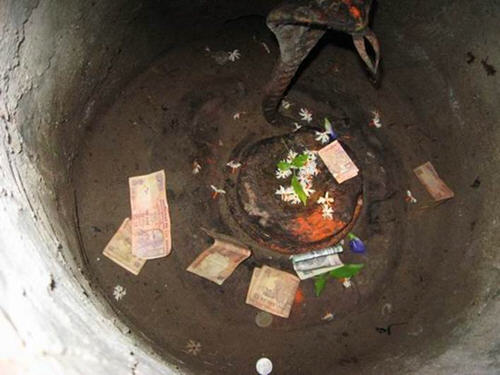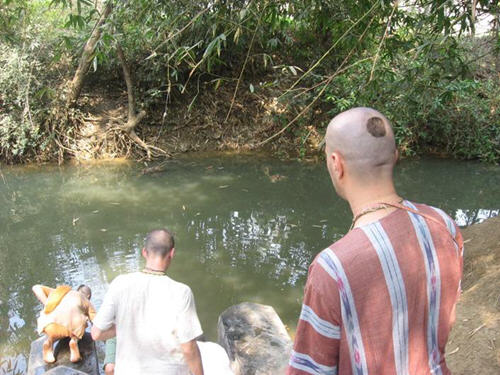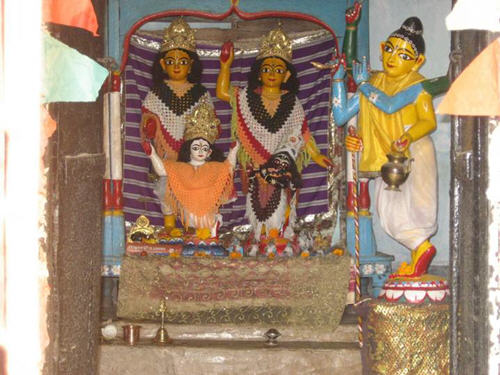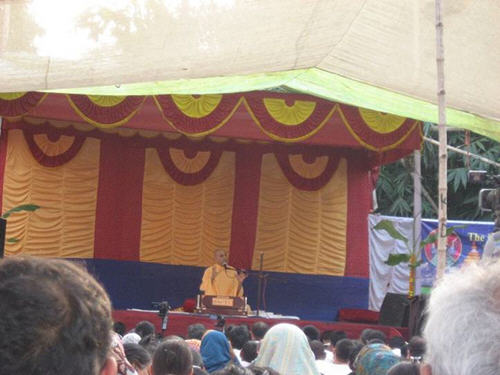
HH Radhanath Swami discussing Nitai Katha- Ekachakra
The childhood pastimes of Nitai were extraordinary. He and His cowherd friends as their childhood play only performed lilas about Krishna and His incarnations. He instructed His cowherd friends how to perfectly play each of their different roles according to the various descriptions given in the Shrimad-Bhagavatam, Tenth Canto, and in the Ramayana. None of the boys were old enough to read books and no one had explained the stories to them in such great detail. Thus from His early childhood His only desire was to re-enact the trancendental pastimes of Lord Krishna. Nitai at times gathered all His friends and closed all the doors and shutters of a house. The house would thus become dark. He would then enact the birth of Lord Krishna, who appeared at midnight. Another time He had a friend dress up as Vasudeva, and the friend, under Nitai's instruction, took a baby doll of Krishna and crossed the little river known as Maundersvara. He and His cowherd friends would sometimes go out and graze the calves. As the cows grazed, they would play their horns and flutes just as they had previously done in Vraja. While out with the cows, Nitai would enact other pastimes as well.
He would dress His friends as Aghasura, Bakasura, Aristasura, Kesi, and re-enact Krishna's pastimes of killing these demons.
Sometimes, unseen by anyone, He would enter a house where milk products were kept and steal butter with His cowherd friends. His cowherd friends never wished to leave His association for a moment. Their parents loved Nitai as well. They never complained or chastised their sons when they came late for their bath or for prasad. Rather the parents themselves used their children's tardiness as an excuse to come and see the glittering moonlike face of Nitaicandra.Sometimes Nitai re-enacted Krishna's pastimes of lifting Govardhan Hill. He would yell to His cowherd friends, "Aniyor! Aniyor!" "Bring more! Bring more!" and His friends would then open up their lunch tiffins and offer everything they had to Nitai. Sometimes He would take all His cowherd friends to a nearby tal forest and vigorously shake the tal trees. He and all His cowherd friends would then enjoy eating the tal fruits. He would thus re-enact Balarama's pastime of killing the ass demon Dhenukasura.
One day He made many hooded snakes from the branches of a bakula tree. He then took His friends to nearby Padmavati Kunda and placed the leaves in the water. He began to elegantly dance upon the leaves, much to the merriment of His friends. When His cowherd friends entered the water as well, they became unconscious. Nitai then revived them as Krishna had revived His cowherd boyfriends after He had subdued Kaliya.Once, completely absorbed in His role, Nitai performed the pastime of fighting in Lanka as Laksmanji. During the pastime, He received a pushpa arrow in His chest and fell down unconscious. He did not awaken for so long that all His friends began crying. They called their parents who, upon seeing Nitai unconscious, also began to cry. At that time one boy remembered that Nitai had previously instructed him to take the role of Hanuman and bring medicinal herbs from Gandharva Hill if He became unconscious while playing this lila. Then this boy, acting like Hanumanji, arrived and held some herbs under Nitai's nose. Everyone watched in amazement as Nitaicandra regained consciousness.
Another time Nitaicandra had a cowherd friend play the role of Akrura as he came to Vraja to take Krishna and Balaram to Mathura. At that time Nitai exhibited the mood of the gopis of Vraja and wept so bitterly, with so much anguish and such intense feelings of separation, that tears gushed in torrents from His eyes. His cowherd friends, feeling the same emotions, also began to cry piteously, wailing, "Krishna! Balaram! Do not leave us. Do not go. Fie on Akrura! Fie on him! Stay with us here and continue herding the cows. We will miss You! Stay with us! Do not go.By this time, the word had spread throughout Ekachakra that something very unusual was transpiring. All the parents of the boys were amazed that Nitai perfectly knew so many transcendental pastimes of Lord Krishna. Some of the more serious minded people suggested that Nityananda Prabhu must be empowered by the I^ord. But in the excitement of their affection for Nitai, they would forget to seriously consider who Nitai was. By the power of His deluding illusory potency, no one fathomed the truth about Shri Nityananda. The people of Ekachakra loved Him more than they loved their own sons, but no one was able to recognize Him as the Lord.
Lord Nityananda lived at home for 12 years, continuously enacting such transcendental pastimes until 1486, the year of Lord Chaitanya's birth in Shridham Mayapur. He then arranged to leave His home. For the next 20 years Nitai travelled to all the holy tirthas of India and ended up in Shri Vrindavan Dham. Around the year 1506, when Lord Chaitanya started His Hari Nama sankirtan pastimes in Shridham Mayapur, Nitai left Vrindavan and came to Shri Navadwip Dham. He hid Himself at Shri Isodhyan in the house of Nandanacarya. His iila of travelling is reminiscent of Lord Balaram's travelling to all the holy places of India, by His own sweet will, during the battle of Kuruksetra.
One evening, shortly after Lord Chaitanya appeared on this earth, a sannyasi with a sun-like effulgence approached the house of Hadai Pandit. Hadai Pandit felt overjoyed for he valued the association of one in the renounced order. He welcomed the sannyasi, but before the sannyasi would accept his hospitality, he told Hadai Pandit that he would only become his guest if Hadai Pandit would satisfy his single request. Hadai Pandit assured the sannyasi that he would do all within his power to satisfy him. He then offerd the sannyasi a comfortable seat, cool water to drink and fresh maha prasadam. That night the sannyasi graced Hadai Pandit's household with discourses on Krishna's Vrindavan pastimes from the Shrimad-Bhagavatam. When Hadai Pandit told this sannyasi that his son Nitai each day playfully enacted many of Krishna's pastimes with His playmates, the sannyasi smiled. The night passed in a twinkling for Hadai Pandit. In the morning, as the sannyasi was preparing to leave, he announced to Hadai Pandit his request. He explained that he was making pilgrimage to all the tirthas, and he needed a good brahmacari to assist him. "Give me your eldest son, Nitai, to assist me," he asked.
When Hadai Pandit heard this heart rendering request, he immediately thought of the Ramayana. He remembered how the sage Visva-mitra had asked King Dasarath for his son Ramacandra, and King Dasarath had to give Rama to the sage. When Shrimati Padmavati devi, who had been listening from the kitchen, heard the sannyasi's request, she felt her heart cracking in two. She thought of Akrura, who had come to Vraja and had taken Krishna and Balaram away to Mathura. Knowing that he must keep his promise, with a heavy heart Hadai Pandit called his son Nitai. With deep sadness he dutifully instructed Nitai to serve this sannyasi attentively, for He was now going to receive the rare opportunity to travel with him and see all the holy tirthas. Embracing his son tightly to his chest, Hadai Pandit placed Him in the custody of the sannyasi and slowly entered his house.People have speculated as to the identity of this effulgent sannyasi. Some want us to accept that the sannyasi was Lord Chaitanya's elder brother Visvarupa. But in 1486, when Shri Nityananda Prabhu left home, Visvarupa had not yet taken sannyasa as he was only about four years old. So this theory is unacceptable. Others say that the sannyasi in question was none other than Laksmipati, the guru of Madha-vendra Puri. But we see in Bhakti-ratnakara that Shri Nityananda Prabhu factually received Vaishnava diksa from Laksmipati at a later date. And if Laksmipati was the same sannyasi that came to Ekachakra, then surely Narahari Cakravarti would have mentioned this fact. Besides that, Laksmipati was very old at the time. He was so old that he could not have been the young sannyasi that came to Ekachakra. Within ten years of this incident, very shortly after he had given Vaishnava diksa to Nityananda Prabhu, he left this world. Thus, as to the identity of this sannyasi, all we know is that he was a Vaishnava in the Brahma Madhva Gaudiya Vaishnava line, either a disciple of Shripad Laksmipati or a disciple of Shri Madhavendra Puri. But by the will of Shri Nityananda Prabhu, his exact identity remains unknown.

Nitai Pada Kamala : One must take the shelter of the lotus feet of Lord Nityananda, for He is the original spiritual master. It is by the mercy of Nitai that we can obtain love of Krishna.
Shri Nityananda Prabhu is the main branch on the trunk of devotional service of Lord Chaitanya. It was He who broke Lord Chaitanya's sannyasa danda on the bank of a river, which is now famous as Danda Banga, the place where the danda was broken. When Mahaprbhu asked Nityananda why He broke His danda, Nitai replied that He could not tolerate seeing Lord Chaitanya carry a dry stick for the rest of His life. A hidden meaning in His breaking the danda is that one stick symbolizes mayavadi advaita vada. It signifies that, "I am brahman." Nityananda Prabhu broke that one danda into three, thus signifying that Vaishnava sannyasis carry three dandas, not one danda. When Mahaprabhu ordered Nityananda to leave Jagannath Puri and deliver Bengal, Nitai came back and lived in Shri Navadwip Dham for sometime and then He came here to Ekachakra. Later He married the two daughters of Suryadas Sarkhela, Jahnava devi and Vasuddha devi, who had also been His wives Revati and Varuni in His previous pastimes as Lord Balaram. At that time, He began living in Kardaha. His son by Vasuddha devi was named Virabhadra.
Shri Nityananda Prabhu is non-different from Lord Balaram and is thus also Mula Sankarsana. He manifests Himself in five forms: Maha Sankarsana, Karanodakasayi, Garbhodakasayi, Kshirodakasayi and Sesha. Shri Nityananda Prabhu is also the presiding Deity of the sandini potency, and as Ananga Manjari, the younger sister of Shrimati Radhika, He renders service to Shri Shri Radha Krishna.After the disappearance of Shri Nityananda Prabhu, Shrimati Jahnava devi and Shri Virabhadra Prabhu came here and remembered the glorious pastimes of Nitai. They became mad in intense separation and started weeping and crying. For many years following the conclusion of Nityananda Prabhu's manifest lila, the village of Ekachakra became completely devoid of people. But now, due to His causeless mercy, people again reside here.
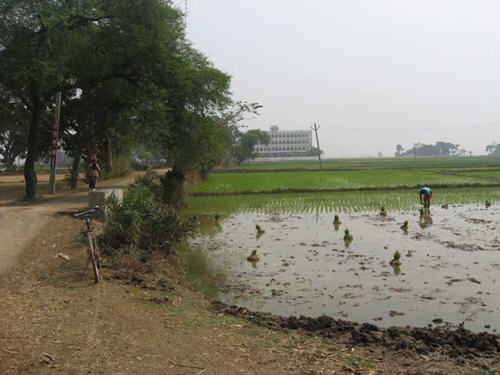
Fields at Ekachakra Dhama
Directions to reach Ekachakra Dhama:
1) Ekachakra is located about 165 km northwest of Mayapur and takes about four hours by car or bus. It is 11 miles north of the town of Rampur Hat in the district of Birbhum. It is 8 miles east of Mallarapura railway station. After Burdwan station is another branch line, which is called a Loop Line of the eastern railway. This is a station on this line called Mallarapura. Ekachakra is 8 miles east of this railway station.
2) Every year during three weeks before Gaura-Purnima, ISKCON Mayapur organizes regular bus services and guided tours to Ekachakra Dhama. Tours leave early in the morning from Mayapur reaching Ekachakra at noon. Tours return back to Mayapur in the evening. Packaged tours to Ekachakra Dhama can also be arranged throughout the year by contacting Mayapur Tourism office on: mtd@pamho.net
Practicalities: There is a small ISKCON temple in Ekachakra. The local devotee can help show you the area. There is a small guest house for pilgrims at the temple where one can stay overnight. This village is very small with limited facilities here.
